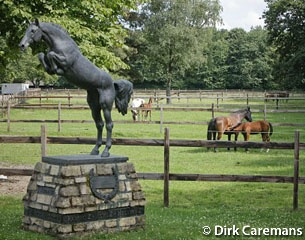
What began over 15 years ago with the birth of Dolly the sheep has developed into a global network of research and innovation which has already had a major impact on the world of dressage. "I first heard about embryonic cloning in the 90's and somatic cloning in 1996 with the birth of Dolly," Eric Palmer, founder of the French cloning company Cryozootech, told Eurodressage.
To develop the equine cloning technique Eric Palmer established a Public Limited Company in France. Set up by him and 15 private shareholders (researchers, veterinarians, breeders and stud farm administrators acting on a private level), Cryozootech is one of just two large scale companies offering horse cloning, the other being ViaTech in Texas.
Studying Agricultural science at the Institut National Agronomique, Eric has also been "a good amateur rider or a bad professional rider" for more than 50 years, but found his true passion in equine reproduction. He has been breeding at a small scale level for forty years, with 1 or 2 of his own brood mares.
As head of the Equine Reproduction Department of INRA for over 30 years, Eric was introduced to ultrasonography, Artificial Insemination, Embryo transfer, and in vitro fertilization in the equine species. "All these technologies are not themselves the future of this industry, but all contribute in helping to genetically improve horse breeding," he stated.
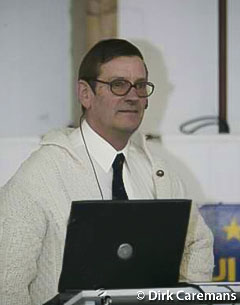 Cloning requires at least 1 square cm of skin, normally taken from a live horse, but this can also be done in the hours, not days, after the horse's death. Producing around 26 cloned horses, from 20 genotypes, Eric got involved in cloning as he felt it was the next logical step, following his previous work at the INRA. "I did not get public funding for this project, but of course I did not accept this situation and decided I would prove that the concept is useful and viable by conducting it privately and at my own risk," he explained. "Money is necessary, but not the target."
Cloning requires at least 1 square cm of skin, normally taken from a live horse, but this can also be done in the hours, not days, after the horse's death. Producing around 26 cloned horses, from 20 genotypes, Eric got involved in cloning as he felt it was the next logical step, following his previous work at the INRA. "I did not get public funding for this project, but of course I did not accept this situation and decided I would prove that the concept is useful and viable by conducting it privately and at my own risk," he explained. "Money is necessary, but not the target."
Commencing his first cloning endeavour in 2001, Eric has spent a lot of his time and money on the venture. He says that while he uses his own clones as stallions, nobody has made money from this business yet! "The standard cost involved in cloning is 200,000 euro. It's our standard price," said Palmer.
Unable to say how many cloning attempts he has undertaken, each horse produced is the result of hundreds of attempts. However, Eric says if you make enough attempts you get the results in almost all cell lines. The first stud to use insemination for mares, as well as the first to try embryotransfer was Zangersheide. It opened the pathway towards cloning more than 30 years ago under the guidance of their chef veterinarian Dr. Leo de Backer. "At the time of the first ever cloning attempt I was a treating vet in most of the important stables in Europe," said Dr De Backer. "My list of clients included Alwin Schockemöhle, Jan Tops, Zangersheide ,Thomas Fruhman, John and Michael Whitacker, Willy Mehlinger, Jean-Claude Van Geensbergen, La Silla (Mexico) and many others."
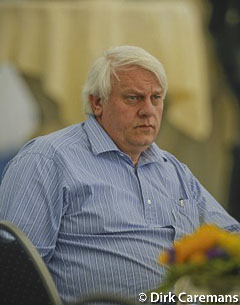 Selected as the treating vet for six Olympic Games Dr De Backer was the acting vet for horses from six different nations in Barcelona. He was obviously internationally demanded so he got approached by Cryozootech to head up Eric Palmer's cloning program. "I knew most of the owners and riders from the most famous horses, the ones that would be very important for his breeding project, and so I became involved," De Backer explained. "I spoke to, and convinced, several people to take, at least, cells from their horses, just in case something happened to them."
Selected as the treating vet for six Olympic Games Dr De Backer was the acting vet for horses from six different nations in Barcelona. He was obviously internationally demanded so he got approached by Cryozootech to head up Eric Palmer's cloning program. "I knew most of the owners and riders from the most famous horses, the ones that would be very important for his breeding project, and so I became involved," De Backer explained. "I spoke to, and convinced, several people to take, at least, cells from their horses, just in case something happened to them."
As a scientist the main reason Dr. De Backer believed in cloning was the fact that at the time many young horses were being castrated because of their difficult character and behaviour. "Also, it was a time when a lot of amateur people owned horses and they couldn’t handle them properly," he explained. "Once gelded, these horses went on to become famous athletes, but once their career as a sporting horse (champion) ended, their genes had already been lost to any breeding project."
The hope was that if they could make a clone from a champion gelding, they could produce a stallion using the same genetic code (semen). "Zangersheide was in that period the only studbook who selected the stallions based on their quality as showjumpers," De Backer added. "Other studbooks were selecting the stallions only by their conformation, i.e, does he look like a good stallion?"
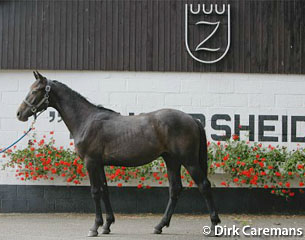 The first ever to order a clone from the Cryozootech team, Leon Melchior had always been interested in scientific developments that focused on anything involved with horses, from artificial insemination and embryo-transplants, to navicular disease and OCD research. "It was not so difficult to convince him of the importance of our project and the possibilities that could come from it," said Dr. De Backer.
The first ever to order a clone from the Cryozootech team, Leon Melchior had always been interested in scientific developments that focused on anything involved with horses, from artificial insemination and embryo-transplants, to navicular disease and OCD research. "It was not so difficult to convince him of the importance of our project and the possibilities that could come from it," said Dr. De Backer.
Taking part in many cloning cases, including ET and Calvaro, Dr. De Backer was especially involved in the Zangersheide stud cloning and currently has several clones in use there. "We now have two Ratina’s, a Chelano, a Top gun, and a Levisto clone. These horses grew up between the other youngsters in the stud as normal horses and they behave like any other horse. In fact the best way to consider a clone is to look at him as a twin brother or sister from the original. There is nothing controversial about it and like I said they behave and develop just like every normal horse."
Dr. De Backer has known the originals very well during their sporting careers and so when entering the field it was not difficult to recognize who was who. "Yes, the clones are very identical to the originals, although there can be a difference in description and pigmentation (i.e an original with a white front leg can give you a clone with a left front leg because the amount of color-cells are identical but there can be a migration of those pigments during the embryonic period.)," said Dr. De Backer about the markings on a clone.
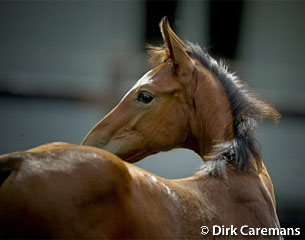 The process of identical and asexual reproduction (cloning) involves the genes of any cell (skin cells for example) being duplicated. Contrary to popular belief a clone is not a genetically modified organism. "It is quite the opposite," Dr. De Backer explained. "A clone is the 100 % original's genetic copy itself. Cell stage manipulations avoid animal suffering, after which the natural gestation process occurs, with a foster mother carrying the foal."
The process of identical and asexual reproduction (cloning) involves the genes of any cell (skin cells for example) being duplicated. Contrary to popular belief a clone is not a genetically modified organism. "It is quite the opposite," Dr. De Backer explained. "A clone is the 100 % original's genetic copy itself. Cell stage manipulations avoid animal suffering, after which the natural gestation process occurs, with a foster mother carrying the foal."
Practically speaking, a biopsy (small sample of tissue) is removed from the donor animal and cells (fibroblasts) extracted from the biopsy are cultured. Then, it is possible to freeze them in liquid nitrogen in view of a quasi-unlimited conservation. Their nucleus contains almost the whole donor animal genetic material. Producing a clone consists in producing an embryo, which will be given all this nucleus' genes. For that purpose, the equine oocyte nucleus will be removed and replaced by the donor animal nucleus. Those handlings require the use of a microscope and micromanipulation apparatus due to the oocyte and nucleus size, 100 and 10 Micron respectively.
Seven extra days will be required for this young embryo to reach the following stage: to be embedded in the uterus of a receiver mare. A gestation can start although it will remain more delicate than a standard one. After a normal gestation period the mare will give birth to a foal. This foal will carry the whole genetic material of the donor animal, as if it were a true twin.
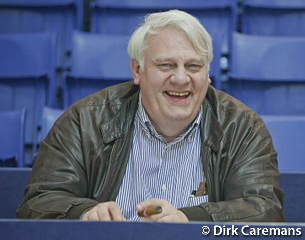 The donor animal is often misconceived as being of a different species and people have commented that it is not a true twin, because of the introduced DNA. "I don’t understand where the people find the fantasy to say that we need to use a part of another animal," said Dr. De Backer, referring to the rumour that frog material is used to clone other animals. This misconception stems from a first successful nucleus transplant achieved in the 1950s with frogs. "We simply use an egg from a mare (any mare) that we collect once the mare has passed on, and we replace the nucleus with the nucleus from the original."
The donor animal is often misconceived as being of a different species and people have commented that it is not a true twin, because of the introduced DNA. "I don’t understand where the people find the fantasy to say that we need to use a part of another animal," said Dr. De Backer, referring to the rumour that frog material is used to clone other animals. This misconception stems from a first successful nucleus transplant achieved in the 1950s with frogs. "We simply use an egg from a mare (any mare) that we collect once the mare has passed on, and we replace the nucleus with the nucleus from the original."
However, despite all the state of the art technology to ensure the clone is a true twin, an individual isn't only made of nuclear genes. "His environment interferes and, although identical, his genes might not be absolutely activated the same way. His mitochodria as well might account for some differences," De Backer admitted. "The DNA of any living creature is the base of what it is, a dog, a human, a horse and so on. But environment can act directly on the organization. That is the reason why we talk about genotype (DNA) and phenotype (what becomes from it due to the environment. Coming back on my comparison with twins. You can imagine that if you have an identical twin, but one is raised in a rich and wealthy environment and climate and the other one in poor circumstances (hunger) and climate, there will be differences when they become adult. On the other hand you can be sure that the semen of a clone is 100% identical with the semen from the original and for breeding purposes there is no difference with the original."
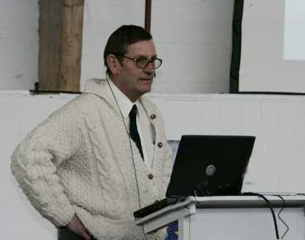 Arguing that the clones are "100% equal as genitors as they distribute the DNA of the model (99% for females because of mitochondrial DNA)," Palmer agrees that the clones can differ from the model because of mitochondrial DNA, but that "this remains theoretical". "They can differ from the model as an organism, which is the result of the animal's genes and its environment. Environment can act directly on the organism (example a disease, an accident, nutrition insufficiency) or through gene programming (the genes are activated or inhibited for the rest of the life after some environment conditions). These differences are not transmitted to the progeny. Some differences are not genetic, such as the place and shape of white marks that are totally random."
Arguing that the clones are "100% equal as genitors as they distribute the DNA of the model (99% for females because of mitochondrial DNA)," Palmer agrees that the clones can differ from the model because of mitochondrial DNA, but that "this remains theoretical". "They can differ from the model as an organism, which is the result of the animal's genes and its environment. Environment can act directly on the organism (example a disease, an accident, nutrition insufficiency) or through gene programming (the genes are activated or inhibited for the rest of the life after some environment conditions). These differences are not transmitted to the progeny. Some differences are not genetic, such as the place and shape of white marks that are totally random."
Asked if you can immediately tell the horse is a true twin, Eric replied that if shown some unknown animals no-one can say that one is a clone, as there is no measurable characteristics of clones. "However, if you ask me is this the clone of XX and you provide DNA sample of XX, then I can confirm or reject the status “clone of XX”!"
Not more susceptible to illness once they have passed the perinatal period, Eric explained the mind of the clone is as other characteristics partly due to genes and therefore moderated by environment. "This is again 'heritability' and according to owners there is a tendency for the animal to be similar in handability and trainabilty, but they may not be very objective," Palmer admitted.
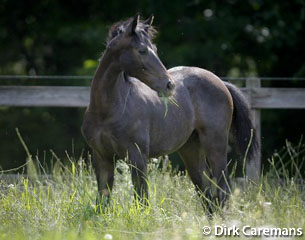 Despite the continuing debate and research into cloning technology, this state-of-the-art technique does offer a new approach to sport horse selection, particularly since the FEI's ruling in June of last year underwent a 180° turn in policy. "The FEI has reversed their previous ruling and made clones eligible to compete in equestrian competition for two reasons," Palmer explained. "The first is that their former argument (“ equality of chance of competitors”) is totally unsustainable when you know the market of performers in the year before Olympic Games (millions of €) compared to the price of cloning. Inequality of chances is already the rule. The other reason is the acceptance of horses of unknown origin in FEI competitions and the impossibility to show that a horse is a clone, making the ban impossible to be legally enforced."
Despite the continuing debate and research into cloning technology, this state-of-the-art technique does offer a new approach to sport horse selection, particularly since the FEI's ruling in June of last year underwent a 180° turn in policy. "The FEI has reversed their previous ruling and made clones eligible to compete in equestrian competition for two reasons," Palmer explained. "The first is that their former argument (“ equality of chance of competitors”) is totally unsustainable when you know the market of performers in the year before Olympic Games (millions of €) compared to the price of cloning. Inequality of chances is already the rule. The other reason is the acceptance of horses of unknown origin in FEI competitions and the impossibility to show that a horse is a clone, making the ban impossible to be legally enforced."
However, while Eric admitted this "new tool in the hands of breeders" will save and distribute the genes of horses that should not have been castrated, those wanting to bring their loved one back to life, will be disappointed. "Some people dream they will get the full copy of the model, some dream of competitions with several clones of the same animal, and others dream of getting back their pet animal," he confessed.
Overall cloning does not change the essence of horse breeding, it just adds another lucrative layer at the very top. "Playing in the game of horse breeding, where you are never sure to win cloning is just having one more card in your hand that can help a little. My hope is not to make multiple identical copies, but just to bring a little acceleration in horse selection," Palmer stated.
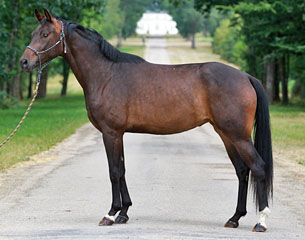 For Dr. De Backer, the interesting thing about cloning is the fact that we can capture the genes for breeding that would otherwise have been lost. "A gelding becomes a stallion again. I believe that in this way cloning can be a very interesting way to improve any breeding program and I’m convinced that in the near future a lot of pedigrees will include clones."
For Dr. De Backer, the interesting thing about cloning is the fact that we can capture the genes for breeding that would otherwise have been lost. "A gelding becomes a stallion again. I believe that in this way cloning can be a very interesting way to improve any breeding program and I’m convinced that in the near future a lot of pedigrees will include clones."
Stressing that clones are normal horses, Dr. De Backer believes there is nothing extraterrestrial about it and is certain we will very quickly see more clones in our sport. "Chelano is approved as a stallion at Zangersheide and ET also has already several offspring. In time, clones will become very normal and they will play their role in both breeding and sport."
by Sarah Warne for Eurodressage
Photos © Dirk Caremans
Related Links
Tom Reed: Pink Flamingos or Pink Horses - The Cloning Crux
Two Jazz Clones Born in the U.S.A.
FEI Sports Forum Directs FEI Dressage Committee to Decide on Blood Rule
E.T. Clone Born at Cryozootech
2006 FEI General Assembly - Summary
Poetin Cloned by Cryozootech